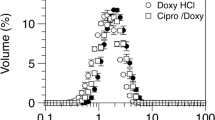Abstract
Two microparticle systems containing disodium cromoglycate (DSCG) alone or with polyvinyl alcohol (DSCG/PVA) were produced via spray drying and compared in terms of their physicochemical characteristics, aerosol performance and drug uptake across a pulmonary epithelial cell line (Calu-3), cultured under air interface conditions. The particle size distribution of DSCG and DSCG/PVA were similar, of spherical geometry, amorphous and suitable for inhalation purposes. Aerosolisation studies using a modified twin-stage impinger showed the DSCG/PVA to have greater aerosol performance than that of DSCG alone. Aerosol particles of DSCG and DSCG/PVA were deposited onto the surface of the Calu-3 air interface epithelium monolayer and the drug uptake from apical to basal directions measured over time. Drug uptake was measured across a range of doses to allow comparison of equivalent drug and powder mass deposition. Analysis of the data indicated that the percentage cumulative drug uptake was independent of the mass of powder deposited, but dependent on the formulation. Specifically, with the formulation containing DSCG, the diffusion rate was observed to change with respect to time (indicative of a concentration-dependent diffusion process), whilst DSCG/PVA showed a time-independent drug uptake (suggesting a zero-order depot release).






Similar content being viewed by others
References
Bilton D, Bruinenberg P, Otulana B, Morishige R, Blanchard J, DeSoyza A, et al. Inhaled liposomal ciprofloxacin hydrochloride significantly reduces sputum Pseudomonas aeruginosa density in CF and non-CF bronchiectasis. Am J Respir Crit Care Med. 2009;179:A3214.
Taylor KMG, Taylor G, Kellaway IW, Stevens J. The influence of liposomal encapsulation on sodium cromoglycate pharmacokinetics in man. Pharm Res. 1989;6(7):633–6.
Salama R. Recent advances in controlled release pulmonary therapy. Curr Drug Deliv. 2009;6(4):404–14.
Zeng XM, Martin GP, Marriott C. The controlled delivery of drugs to the lung. Int J Pharm. 1995;124(2):149–64.
Salama RO, Traini D, Chan H-K, Young PM. Preparation and characterisation of controlled release co-spray dried drug–polymer microparticles for inhalation 2: evaluation of in vitro release profiling methodologies for controlled release respiratory aerosols. Eur J Pharm Biopharm. 2008;70(1):145–52.
Salama R, Hoe S, Chan H-K, Traini D, Young PM. Preparation and characterisation of controlled release co-spray dried drug-polymer microparticles for inhalation 1: influence of polymer concentration on physical and in vitro characteristics. Eur J Pharm Biopharm. 2008;69(2):486–95.
Online databese Stationery Office. British Pharmacopoeia Volumes I & II, Part II, Official Standards, Solubility. London. 2011. http://www.pharmacopoeia.co.uk. Accessed 12 June 2011.
Salama R, Ladd L, Chan H-K, Traini D, Young P. Development of an in vivo ovine dry powder inhalation model for the evaluation of conventional and controlled release microparticles. AAPS J. 2009;11(3):465–8.
Yamamoto A, Yamada K, Muramatsu H, Nishinaka A, Okumura S, Okada N, et al. Control of pulmonary absorption of water-soluble compounds by various viscous vehicles. Int J Pharm. 2004;282(1–2):141–9.
Foster KA, Avery ML, Yazdanian M, Audus KL. Characterization of the Calu-3 cell line as a tool to screen pulmonary drug delivery. Int J Pharm. 2000;208(1–2):1–11.
Bur M, Rothen-Rutishauser B, Huwer H, Lehr C-M. A novel cell compatible impingement system to study in vitro drug absorption from dry powder aerosol formulations. Eur J Pharm Biopharm. 2009;72(2):350–7.
Sporty JL, Horalkova L, Ehrhardt C. In vitro cell culture models for the assessment of pulmonary drug disposition. Expert Opin Drug Metab Toxicol. 2008;4(4):333–45.
Grainger C, Greenwell L, Lockley D, Martin G, Forbes B. Culture of Calu-3 cells at the air interface provides a representative model of the airway epithelial barrier. Pharm Res. 2006;23(7):1482–90.
Fernandes CA, Vanbever R. Preclinical models for pulmonary drug delivery. Expert Opin Drug Deliv. 2009;6:1231–45.
Mathias NR, Yamashita F, Lee VHL. Respiratory epithelial cell culture models for evaluation of ion and drug transport. Adv Drug Deliv Rev. 1996;22(1–2):215–49.
Haghi M, Young PM, Traini D, Jaiswal R, Gong J, Bebawy M. Time- and passage-dependent characteristics of a Calu-3 respiratory epithelial cell model. Drug Dev Ind Pharm. 2010;36(10):1207–14.
Endter S, Francombe D, Ehrhardt C, Gumbleton M. RT-PCR Analysis of ABC, SLC and SLCO drug transporters in human lung epithelial cell models. J Pharm Pharmacol. 2009;61(5):583–91.
Forbes B, Ehrhardt C, Forbes B, Ehrhardt C. Human respiratory epithelial cell culture for drug delivery applications. Eur J Pharm Biopharm. 2005;60(2):193–205.
Grainger CI, Greenwell LL, Martin GP, Forbes B. The permeability of large molecular weight solutes following particle delivery to air-interfaced cells that model the respiratory mucosa. Eur J Pharm Biopharm. 2009;71(2):318–24.
Hein S, Bur M, Schaefer UF, Lehr C-M. A new pharmaceutical aerosol deposition device on cell cultures (PADDOCC) to evaluate pulmonary drug absorption for metered dose dry powder formulations. Eur J Pharm Biopharm. 2011;77(1):132–8.
Online databese Stationery Office. British Pharmacopoeia, Appendix XII C London. 2011. http://www.pharmacopoeia.co.uk. Accessed 01 June 2011.
Pritchard JN. The influence of lung deposition on clinical response. J Aerosol Med. 2001;14(1):S19–26.
Tolani S. A method for viable cell count. Method Cell Sci. 1975;1(1):37–8.
Xu Z, Mansour HM, Mulder T, McLean R, Langridge J, Hickey AJ. Dry powder aerosols generated by standardized entrainment tubes from drug blends with lactose monohydrate: 1. Albuterol sulfate and disodium cromoglycate. J Pharm Sci. 2010;99(8):3398–414.
Jeong Kim S, Jun Park S, Young Kim I, Hee Lee Y, Kim SI. Thermal characteristics of poly(vinyl alcohol) and poly(vinylpyrrolidone) IPNs. J Appl Polym Sci. 2002;86(8):1844–7.
Patton JS, Byron PR. Inhaling medicines: delivering drugs to the body through the lungs. Nat Rev Drug Discov. 2007;6(1):67–74.
Hartshorne NH, Woodard GD. Mesomorphism in the system disodium chromoglycate–water. In: Molecular crystals and liquid crystals. Great Britain: Gordon and Breach Science Publishers; 1973. p. 343–68.
Chamipon JV, Meeten GH. Conformation of sodium cromolyn in aqueous solution using light scattering and magnetic birefringence. J Pharm Sci. 1973;62(10):1589–95.
Ong H, Traini D, Bebawy M, Young P. Epithelial profiling of antibiotic controlled release respiratory formulations. Pharm Res. 2011;28:2327–38. doi:10.1007/s11095-011-0462-1.
Author information
Authors and Affiliations
Corresponding author
Rights and permissions
About this article
Cite this article
Haghi, M., Salama, R., Traini, D. et al. Modification of Disodium Cromoglycate Passage Across Lung Epithelium In Vitro Via Incorporation into Polymeric Microparticles. AAPS J 14, 79–86 (2012). https://doi.org/10.1208/s12248-011-9317-2
Received:
Accepted:
Published:
Issue Date:
DOI: https://doi.org/10.1208/s12248-011-9317-2




